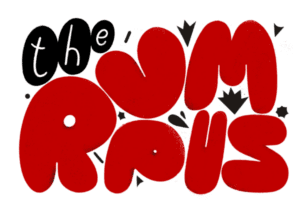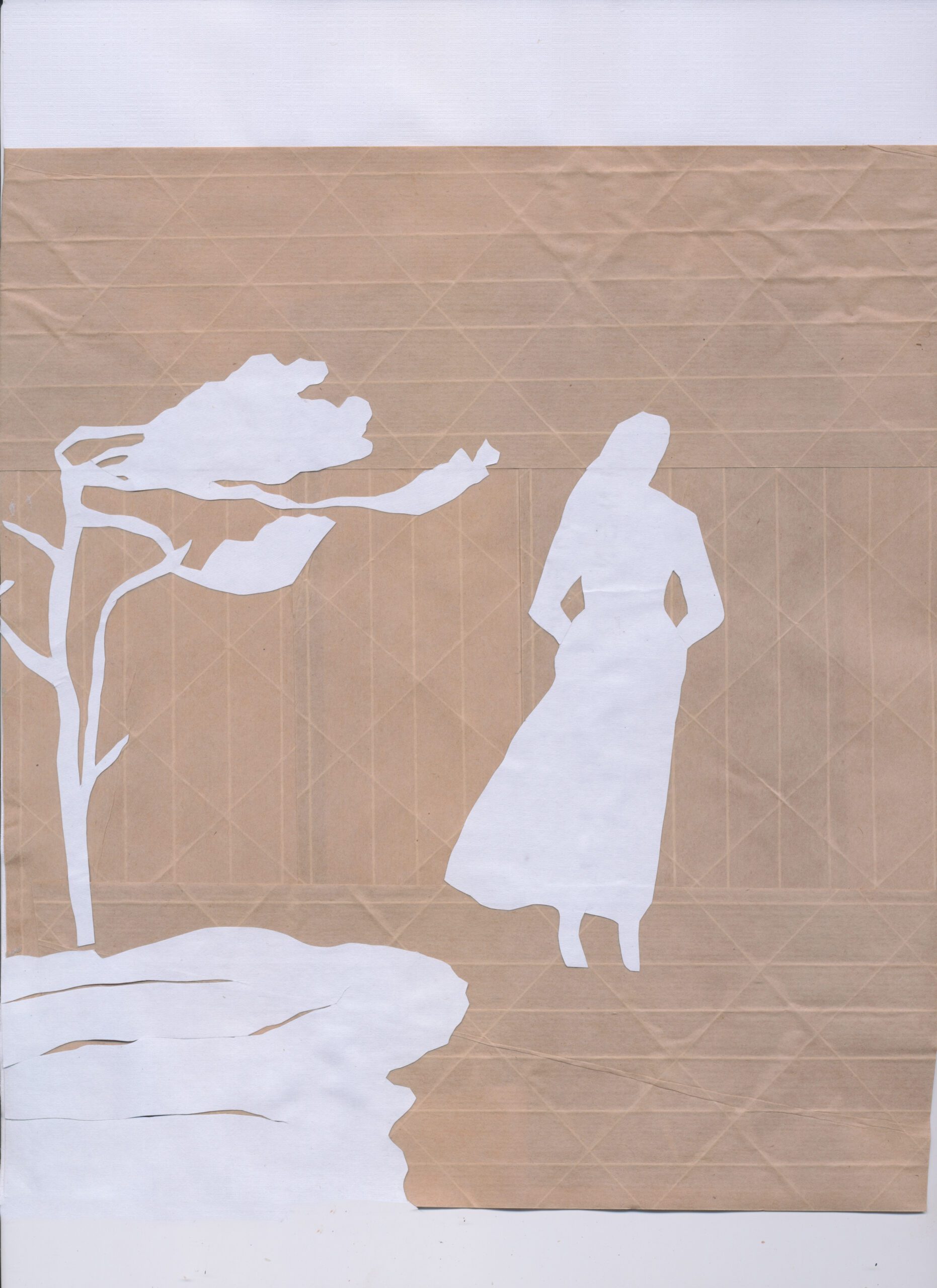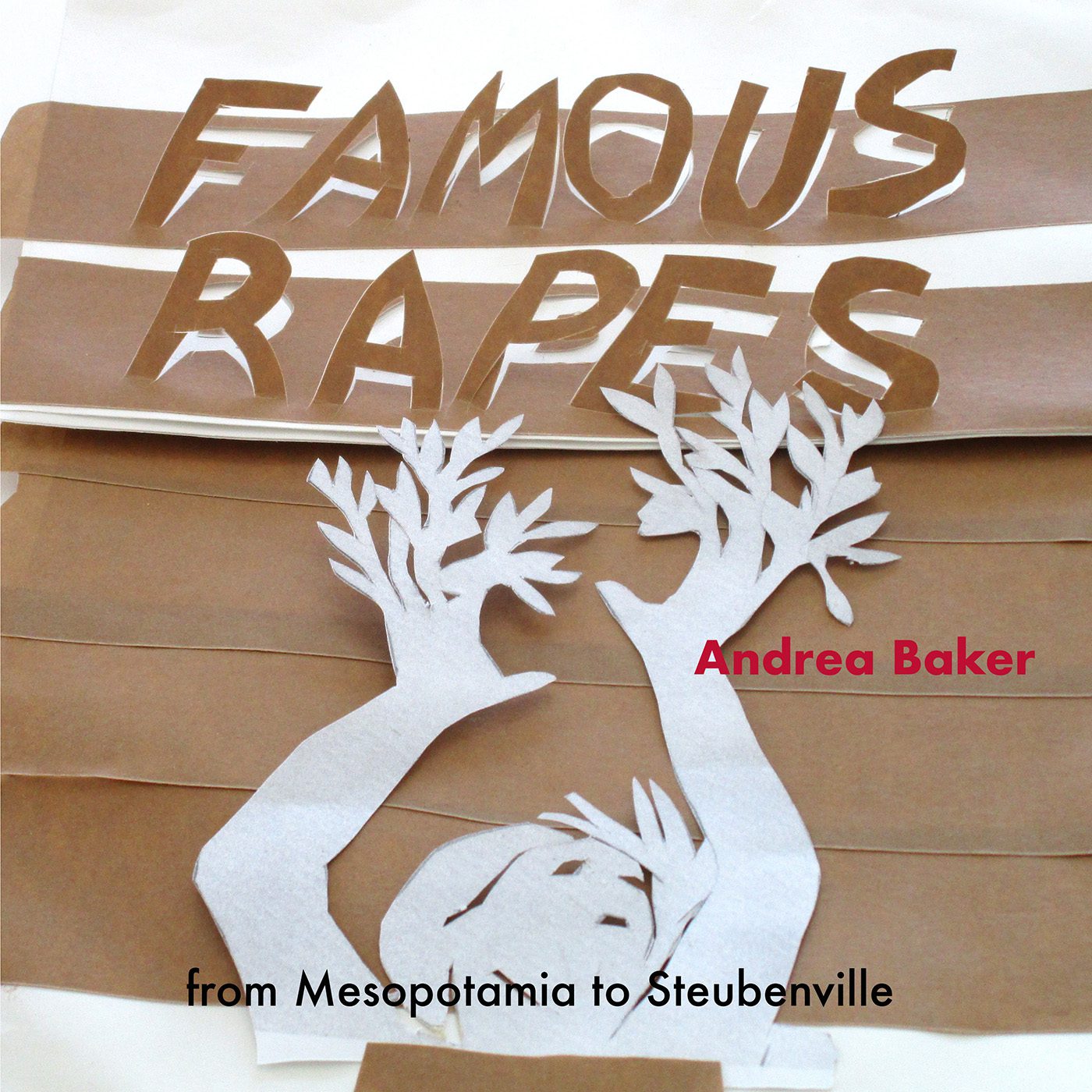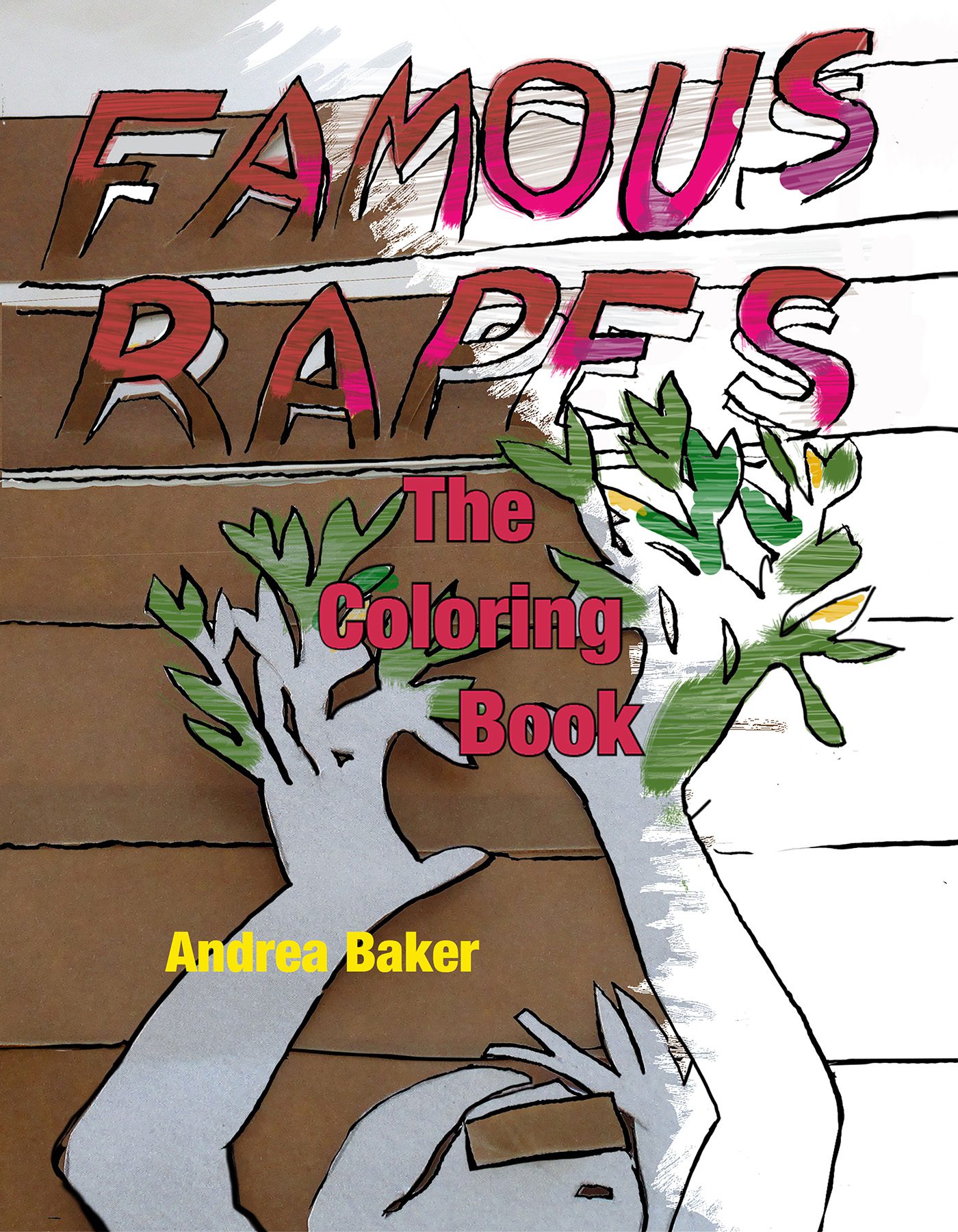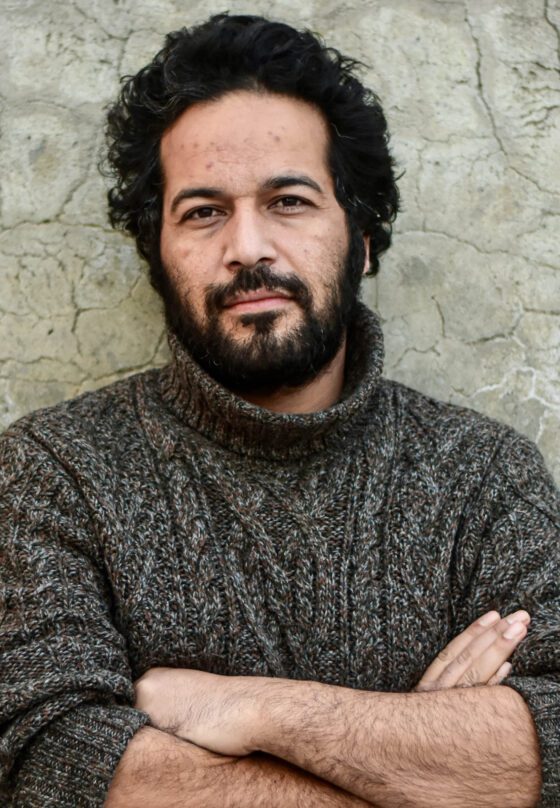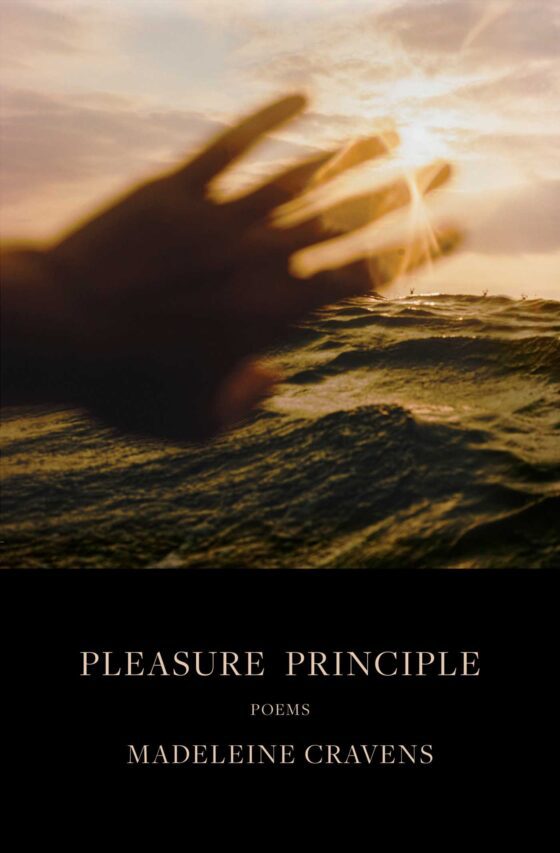
Several years ago, Andrea Baker created a miniseries of collage art and text for The Rumpus called “Famous Rapes.” The images, made from paper cutouts and paper packing tape, depict well-known stories, events, and myths of rape throughout history. The stark language of the accompanying text makes the horrors inescapable. Baker has since extended the powerful series into a book, Famous Rapes: Rape Culture from the Sabine Women to the Steubenville, Ohio Football Players, forthcoming from Water Street Press.
As a classical studies student, I was familiar with Greek myths, such as Persephone being captured and imprisoned in Hell and Daphne praying to turn into a tree rather than suffer at the hands of Apollo. Rapere, “to capture, seize, take away,” was one of my early Latin vocabulary words, a likely root of the word rape. For a long time, these myths and vocabulary seemed distant from the world I inhabited.
Baker’s book collapses that distance. With her clear poet voice and art inspired by her everyday life as an antiques dealer, Baker presents a haunting and important reflection of famous rapes, tracing the history of myths and stories to our current cultural climate. The images include recreations of master paintings and original interpretations of events, all demanding the reader view these stories afresh.
Baker spoke with me over email about the process of creating her hybrid book and the power of image.
***
The Rumpus: In your author’s note you write, “Reader, if you are suffering, this note is for you. And, reader, if you have ever stood up for what you believe in, this note is for you.” I was struck by how directly you offer your writing to the readers, anticipating our desire to connect with you and not be afraid to read on, even when the subject material is heavy. Do you have any texts or pieces of art that reached out to you when you were suffering or standing up for what you believed in? How did those artists influence your approach to Famous Rapes?
Andrea Baker: I attended a therapy writing group for a bit. It had nothing to do with writing for any reason other than healing. I felt a little ashamed to be there, but I had a breakthrough moment in that group. The therapist introduced the poem we were about to read as being about boundaries, then handed out Mary Oliver’s poem “The Journey.”
At the time, I was working on extricating myself from an abusive relationship. In the poem Oliver speaks of “…the old tug / at your ankles” that cries ‘Mend my life!’” I could relate. I had an acute awareness of others’ needs, and others’ pleas, and my attempts to satisfy those needs, and it was killing me. In the poem the speaker acknowledges the cries, and the stakes. Oliver writes “you strode deeper and deeper / into the world, / determined to do / the only thing you could do— / determined to save / the only life that you could / save.”
A lot of people had tried to talk to me about boundaries. I had no idea what they meant. But this therapist had just communicated to me in my own language and I suddenly knew the meaning of boundaries. I had to save my own life. I had the right to save my own life. And, at the end of the day, my own is the only life I can save.
In terms of form and creative expression I could make a list of influences a mile long. But that poem, along with a small handful of other Oliver poems, are the pieces that really reached me when I was suffering. I don’t really know the answer to whether they influenced Famous Rapes, but I can say that writing/making the book was also an act of self-preservation, in the sense that there was this material that I needed to work through. I had to understand how I had gotten into, and stayed in, a relationship where I had no ownership of my own body. I needed to understand not just my own personal narrative, but also the cultural narratives around the autonomy and dignity of women.
Rumpus: You also write, “This book is about reflecting on the history of our proverbial water so we might bring the joy of accomplishment to our continuing work.” The rapes you describe span a large swath of history—from the Greco-Roman world to American post-Civil War Reconstruction to the 21st century where social media is a primary source for communication. What was your approach to researching the history of our shared water? How did you determine which rapes to include?
Baker: It started with the old master paintings. I became a vegetarian at thirteen. It happened on the day I really, really realized that cows and beef are the same thing. Similarly, one day I saw an image of a painting and really, really realized that, in that painting, romance and sexual assault were the same thing.
I started remaking old master images out of paper and packing tape, just to get the horror out of my system. That project gave me some sympathy for myself. It felt less like there was something wrong with me and more like there was something wrong with the culture.
I became interested in feminism in a new way, and I started reading around. Susan Brownmiller’s Against Our Will, Susan Estrich’s Real Rape, and Lisa Cuklanz’s Rape on Trial all gave me a groundwork for how insidious rape culture is, as well as some insight into the social arenas in which it plays out. I felt a drive to track the things they were talking about. Making the cutouts helped me work through it all. Whatever disturbed me the most made it into the book.
Rumpus: With many of the myths and stories of rape, there are lessons and values the listener is supposed to take away. For example, in the story of St. Ebba, she and her fellow nuns cut off their noses and upper lips so that the Vikings will find them too grotesque to rape, and you write: “The lesson is that self-inflicted violence and death are righteous acts if a woman’s purity is at stake.” As a poet and writer, you know the significance of language and its effect on readers. What was the process of writing in an objective, plain voice to describes these horrific outcomes like for you? Why did you choose to write in this register?
Baker: I don’t really feel like I chose it. It was the only option. The whole project was a process of saying, to myself, “…ohhhh…” Like—now I get why things today are the way they are. St. Ebba is my favorite character. I adore her because I understand her impulse, and understanding her impulse, and the fact that her impulse was celebrated—the resonate meanings of that—that all explains to me why my instincts are such that I can understand her. There are vague overtones of times in which women were completely devalued still ringing through the tunnel of history and into our lives today—but we hear these overtones without ever getting to look squarely at the facts. This project came about because I needed to know what the facts were. I helped me see my experiences as a microcosm of history, or history as a macrocosm through which I might come to terms with the broad truths of my own experiences. And it helped me position myself in a way in which I was much less alone.
Rumpus: You’ve said that as an antiques dealer, packing tape is part of your everyday visual world, and so the medium of packing tape and paper for the visual art is another example of how you invite the readers into the book and walk us through challenging content. The stark contrast between the white and dark papers forces us to reflect on each image, to acknowledge the realities of our history and the present. Can you talk through your process of creating these images, and speak to how they relate to the written content of the book?
Baker: The images, for me, are much more primary than the words. I’m sure there’s some brain science about the mind’s limited capacity for language when grappling with trauma. I don’t know what those facts are, but I do know that processing extremely difficult material through the slow work of creating obsessive, meticulous models of the images that were bothering me held me in a meditative state in a way that language never could. My own feeling about the book now is that the language is there as connective tissue, but the work of the piece is accomplished by the images—they hold the emotion.
Rumpus: You recognized the importance of examining and challenging rape culture when you started this project, several years before the most recent #MeToo and the #TimesUp movements. Have these movements shaped your later writing or revision processes? Are there concerns that you would like to see addressed in these movements?
Baker: Famous Rapes is important to me, but I don’t see myself staying with the subject of rape culture in future projects. In terms of concerns, I find that even a show as advocacy-based as Law & Order SVU has a habit of slipping into condoning sexual assault in prison as a just reward for “bad men.” I think this is a blind spot.
Rumpus: In the final chapter of the book, “Moral Evolution,” you walk through the radical shifts on the perception of rape: survival is now a good thing, women are seen as the victims because they’re not the property of men, and steps are being taken to address the needs of survivors. You end with a hopeful thought: “Freedom begins with awareness, and we are in the process of becoming free.” How do you see Famous Rapes contributing to that process of becoming free? What other acts do you hope to see in the future that will help set us free?
Baker: I’m really just working on myself. I believe that if we all work on ourselves, from there everything else will come.
Hoffman: Is there anything else about your work you’d like to add?
Baker: Yes! I have totally neglected to mention Famous Rapes: The Coloring Book. The book-book was first supposed to come out about five years ago. It was delayed by the press. In the meantime, I began noticing adult coloring books, and the power they had as a new cultural vehicle. My coloring book doesn’t take on the breadth or depth of material included in the book-book; instead, it hones in on celebrating the strides we have made, while also emphasizing that one of the strides is having the space to grieve our collective narrative. It begins, “Rape was grace. / It was upward sweeping. / It was Romance. / And duty. / And Right.” It goes through images of heroes raping, of Gods raping, and of women being punished for their rapes, into images of protest and survival. My attraction to the coloring book is not dissimilar to my attraction to lyrical poetry. They are both about letting images speak, and giving images room to breathe.
